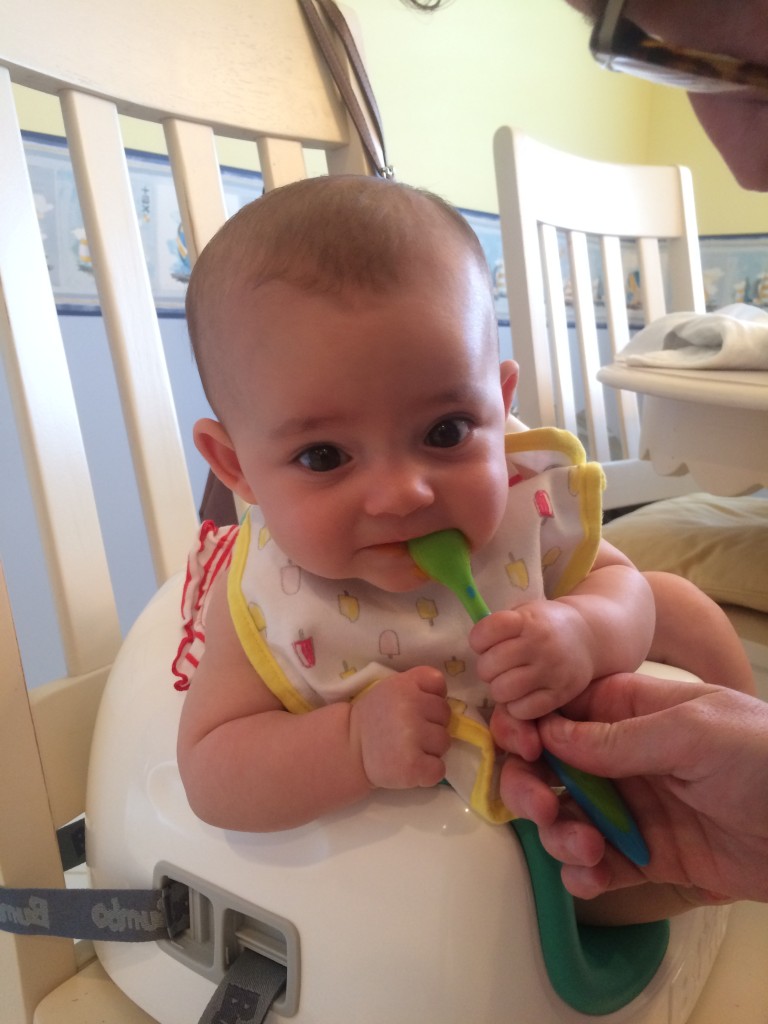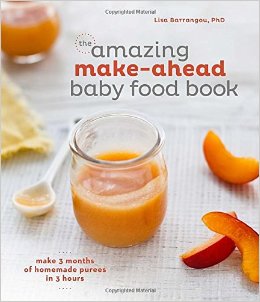(Baby) book review: The Amazing Make-Ahead Baby Food Book, by Lisa Barrangou
Being a parent of an infant so often involves navigating through one murky, doubt-filled morass after another, trying to reconcile all of the conflicting advice you’ve received. Everyone — the internet, your pediatrician, your neighbor, your friend, your mom — has a different bit of wisdom to share and it’s often hard to know which way is up when fumbling your way through growth spurts, developmental leaps, teething, and, of course, the introduction of solid foods. Luckily for me, I received Lisa Barrangou’s The Amazing Make-Ahead Baby Food Book, which takes all of the guesswork out of introducing solid foods to baby.
Like every new mother, I’d received a mountain of conflicting advice on how and when to introduce solids, what types of solids to introduce first, whether to do baby-led weaning or purees, how to space solids so as to avoid allergic reactions, and so on. I found myself confused, which has pretty much become my default posture in life since Lucia was born. Enter The Amazing Make-Ahead Baby Food Book, which promises to guide you through making three months’ worth of homemade purees in three hours. Hallelujah!
Barrangou is a “former corporate food scientist” with an MS and PhD in food science. Her approach emphasizes whole, unprocessed foods, and starts with introducing fruits and veggies, rather than rice cereal or other grains. I was quickly sold on Barrangou’s bona fides and her approach, since I was reticent to give Lucia processed cereal as a first food and liked the idea of starting her off with vegetables, instead.
The book lays out a wonderfully simple and straightforward strategy for introducing solids that includes selecting a menu of whole foods, preparing a shopping list, creating space to store the foods, shopping, creating a mise en place plan, and preparing the food. Barrangou helpfully includes a list of supplies you need, including silicone ice cube trays, a steamer, a food processor or blender, and freezer bags. The plan she suggests is clear, concise, and sensible, and boy, do I love a good mise en place.
The book leaves nothing to chance, explaining clearly how to prepare each food with helpful charts and recipes. It also goes over which foods to limit or avoid (e.g., honey, cow’s milk, high acid fruits, etc.), which to buy organic (the so-called “dirty dozen”), when to introduce solids, in which order to introduce foods, how to ensure diversity of flavors and textures, how to avoid choking, what to look out for in terms of allergies and sensitivities, safe food prep practices, and flavor combos. I love how idiot-proof this book is.
The best part of the book, in my opinion, is the sample three-month menu of meals for baby, which sets out a simple yet diversified menu to follow, starting with pureed sweet potatoes and progressing to such exotic combos as avocado, mango, and black beans. Barrangou says you can follow her sample menu exactly or you can create your own based on the vast array of whole foods set out in the book. I decided to follow her sample menu and started, as suggested, with sweet potatoes.

I introduced sweet potatoes to Lucia at five months old, and she LOVED the experience. She gobbled up the sweet potatoes and then, a few days later, sweet peas with relish! Unfortunately, her guts were not as enthused and she had some pretty gnarly stomach distress for about a week after starting solids, so I decided to hold off until her six month birthday to try again. Luckily, I already have a whole bag of frozen sweet potato cubes in the freezer, ready to go, and armed with Barrangou’s book, it’ll be easy to prepare several months’ worth of food some afternoon over this coming week.

If it’s not clear, I think this book is absolutely fantastic and I’d recommend it heartily to any parent who’s looking for a healthy, easy, no-nonsense way to introduce whole foods to a baby. As a bonus, the book is gorgeous and the photographs make me want to puree myself up some bananas and go to town.
I received this book from the Blogging for Books program in exchange for this review.
